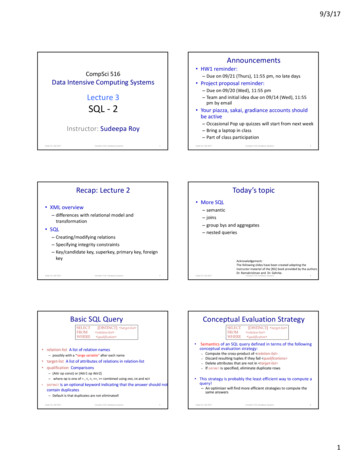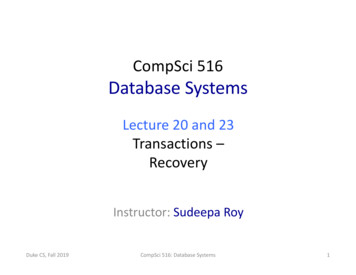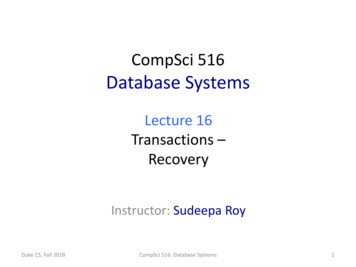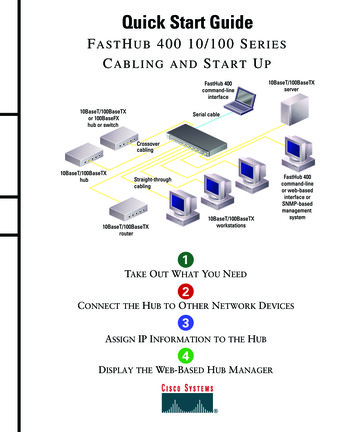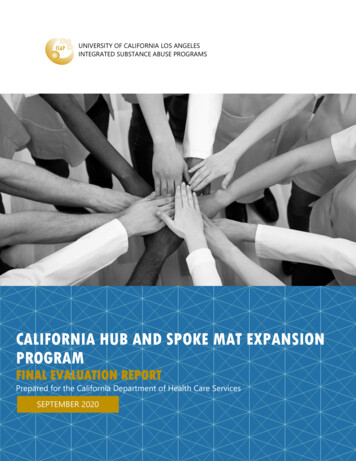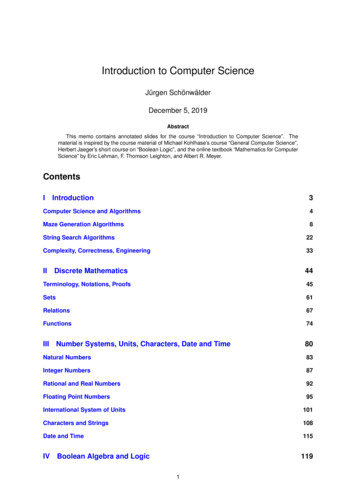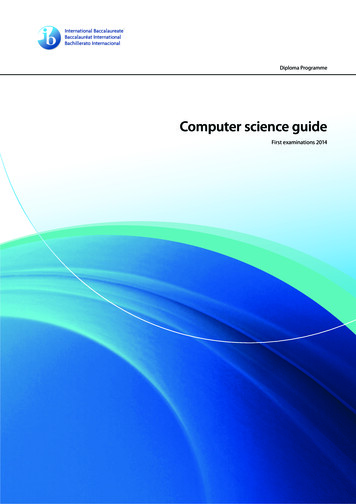
Transcription
Diploma ProgrammeComputer science guideFirst examinations 2014
Diploma ProgrammeComputer science guideFirst examinations 2014
Diploma ProgrammeComputer science guidePublished January 2012Published on behalf of the International Baccalaureate Organization, a not-for-profiteducational foundation of 15 Route des Morillons, 1218 Le Grand-Saconnex, Geneva,Switzerland by theInternational Baccalaureate Organization (UK) LtdPeterson House, Malthouse Avenue, Cardiff GateCardiff, Wales CF23 8GLUnited KingdomPhone: 44 29 2054 7777Fax: 44 29 2054 7778Website: www.ibo.org International Baccalaureate Organization 2012The International Baccalaureate Organization (known as the IB) offers three high-qualityand challenging educational programmes for a worldwide community of schools, aimingto create a better, more peaceful world. This publication is one of a range of materialsproduced to support these programmes.The IB may use a variety of sources in its work and checks information to verify accuracyand authenticity, particularly when using community-based knowledge sources such asWikipedia. The IB respects the principles of intellectual property and makes strenuousefforts to identify and obtain permission before publication from rights holders of allcopyright material used. The IB is grateful for permissions received for material usedin this publication and will be pleased to correct any errors or omissions at the earliestopportunity.All rights reserved. No part of this publication may be reproduced, stored in a retrievalsystem, or transmitted, in any form or by any means, without the prior written permissionof the IB, or as expressly permitted by law or by the IB’s own rules and policy. Seehttp://www.ibo.org/copyright.IB merchandise and publications can be purchased through the IB store athttp://store.ibo.org. General ordering queries should be directed to the Sales andMarketing Department in Cardiff.Phone: 44 29 2054 7746Fax: 44 29 2054 7779Email: sales@ibo.orgInternational Baccalaureate, Baccalauréat International and Bachillerato Internacionalare registered trademarks of the International Baccalaureate Organization.Printed in the United Kingdom by Antony Rowe Ltd, Chippenham, Wiltshire4061
IB mission statementThe International Baccalaureate aims to develop inquiring, knowledgeable and caring young people who help tocreate a better and more peaceful world through intercultural understanding and respect.To this end the organization works with schools, governments and international organizations to developchallenging programmes of international education and rigorous assessment.These programmes encourage students across the world to become active, compassionate and lifelong learnerswho understand that other people, with their differences, can also be right.IB learner profileThe aim of all IB programmes is to develop internationally minded people who, recognizing their commonhumanity and shared guardianship of the planet, help to create a better and more peaceful world.IB learners strive to be:InquirersThey develop their natural curiosity. They acquire the skills necessary to conduct inquiryand research and show independence in learning. They actively enjoy learning and thislove of learning will be sustained throughout their lives.KnowledgeableThey explore concepts, ideas and issues that have local and global significance. In sodoing, they acquire in-depth knowledge and develop understanding across a broad andbalanced range of disciplines.ThinkersThey exercise initiative in applying thinking skills critically and creatively to recognize andapproach complex problems, and make reasoned, ethical decisions.CommunicatorsThey understand and express ideas and information confidently and creatively in morethan one language and in a variety of modes of communication. They work effectivelyand willingly in collaboration with others.PrincipledThey act with integrity and honesty, with a strong sense of fairness, justice and respectfor the dignity of the individual, groups and communities. They take responsibility fortheir own actions and the consequences that accompany them.Open-mindedThey understand and appreciate their own cultures and personal histories, and are opento the perspectives, values and traditions of other individuals and communities. They areaccustomed to seeking and evaluating a range of points of view, and are willing to growfrom the experience.CaringThey show empathy, compassion and respect towards the needs and feelings of others.They have a personal commitment to service, and act to make a positive difference to thelives of others and to the environment.Risk-takersThey approach unfamiliar situations and uncertainty with courage and forethought, andhave the independence of spirit to explore new roles, ideas and strategies. They are braveand articulate in defending their beliefs.BalancedThey understand the importance of intellectual, physical and emotional balance toachieve personal well-being for themselves and others.ReflectiveThey give thoughtful consideration to their own learning and experience. They are ableto assess and understand their strengths and limitations in order to support their learningand personal development. International Baccalaureate Organization 2007
ContentsIntroduction1Purpose of this document1The Diploma Programme2Nature of the subject4Aims8Assessment objectives9Assessment objectives in practice10Syllabus11Syllabus outline11Approaches to the teaching and learning of computer science12Syllabus content17Assessment65Assessment in the Diploma Programme65Assessment outline—SL67Assessment outline—HL68External assessment70Internal assessment75Summary of the group 4 project87Appendices93Glossary of command terms93Further reading95Computer science guidevii
IntroductionPurpose of this documentThis publication is intended to guide the planning, teaching and assessment of the subject in schools.Subject teachers are the primary audience, although it is expected that teachers will use the guide to informstudents and parents about the subject.This guide can be found on the subject page of the online curriculum centre (OCC) at http://occ.ibo.org, apassword-protected IB website designed to support International Baccalaureate (IB) teachers. It can also bepurchased from the IB store at http://store.ibo.org.Additional resourcesAdditional publications such as teacher support materials, subject reports, internal assessment guidanceand grade descriptors can also be found on the OCC. Specimen and past examination papers as well asmarkschemes can be purchased from the IB store.Teachers are encouraged to check the OCC for additional resources created or used by other teachers.Teachers can provide details of useful resources, for example, websites, books, videos, journals or teachingideas.AcknowledgmentThe IB wishes to thank the educators and associated schools for generously contributing time and resourcesto the production of this guide.First examinations 2014Computer science guide1
IntroductionThe Diploma ProgrammeThe Diploma Programme is a rigorous pre-university course of study designed for students in the 16 to 19age range. It is a broad-based two-year course that aims to encourage students to be knowledgeable andinquiring, but also caring and compassionate. There is a strong emphasis on encouraging students todevelop intercultural understanding, open-mindedness, and the attitudes necessary for them to respectand evaluate a range of points of view.The Diploma Programme hexagonThe course is presented as six academic areas enclosing a central core. It encourages the concurrentstudy of a broad range of academic areas. Students study: two modern languages (or a modern languageand a classical language); a humanities or social science subject; an experimental science; mathematics;one of the creative arts. It is this comprehensive range of subjects that makes the Diploma Programme ademanding course of study designed to prepare students effectively for university entrance. In each of theacademic areas students have flexibility in making their choices, which means they can choose subjects thatparticularly interest them and that they may wish to study further at university.Studies in languageand literatureGroup 1Group 2Group 3Individualsand societiesessayedndPR sitionEExperimentalsciencesGroup 4creaicetivity, action, servGroup 5MathematicsGroup 6The artsFigure 1Diploma Programme model2Computer science guide
The Diploma ProgrammeChoosing the right combinationStudents are required to choose one subject from each of the six academic areas, although they can choosea second subject from groups 1 to 5 instead of a group 6 subject. Normally, three subjects (and not morethan four) are taken at higher level (HL), and the others are taken at standard level (SL). The IB recommends240 teaching hours for HL subjects and 150 hours for SL. Subjects at HL are studied in greater depth andbreadth than at SL.At both levels, many skills are developed, especially those of critical thinking and analysis. At the end ofthe course, students’ abilities are measured by means of external assessment. Many subjects contain someelement of coursework assessed by teachers. The course is available for examinations in English, French andSpanish.The core of the hexagonAll Diploma Programme students participate in the three course requirements that make up the core ofthe hexagon. Reflection on all these activities is a principle that lies at the heart of the thinking behind theDiploma Programme.The theory of knowledge course encourages students to think about the nature of knowledge, to reflecton the process of learning in all the subjects they study as part of their Diploma Programme course, andto make connections across the academic areas. The extended essay, a substantial piece of writing of up to4,000 words, enables students to investigate a topic of special interest that they have chosen themselves.It also encourages them to develop the skills of independent research that will be expected at university.Creativity, action, service involves students in experiential learning through a range of artistic, sporting,physical and service activities.The IB mission statement and the IB learner profileThe Diploma Programme aims to develop in students the knowledge, skills and attitudes they will needto fulfill the aims of the IB, as expressed in the organization’s mission statement and the learner profile.Teaching and learning in the Diploma Programme represent the reality in daily practice of the organization’seducational philosophy.Computer science guide3
IntroductionNature of the subjectComputer science requires an understanding of the fundamental concepts of computational thinking aswell as knowledge of how computers and other digital devices operate.The Diploma Programme computer science course is engaging, accessible, inspiring and rigorous. It has thefollowing characteristics. draws on a wide spectrum of knowledge enables and empowers innovation, exploration and the acquisition of further knowledge interacts with and influences cultures, society and how individuals and societies behave raises ethical issues is underpinned by computational thinking.Computational thinking involves the ability to: think procedurally, logically, concurrently, abstractly, recursively and think ahead utilize an experimental and inquiry-based approach to problem-solving develop algorithms and express them clearly appreciate how theoretical and practical limitations affect the extent to which problems can be solvedcomputationally.During the course the student will develop computational solutions. This will involve the ability to: identify a problem or unanswered question design, prototype and test a proposed solution liaise with clients to evaluate the success of the proposed solution and make recommendations forfuture developments.Computer science has links with subjects outside of group 4, notably information technology in a globalsociety (ITGS), but it should be noted that there are clear differences between the subjects.Computer science and the international dimensionComputer science itself is an international endeavour—the exchange of information and ideas across nationalboundaries has been essential to the progress of the subject. This exchange is not a new phenomenon butit has accelerated in recent times with the development of information and communication technologies.The development of solutions may be at a local, national or global scale and lies at the heart of the subject.Therefore teachers of computer science should study a range of examples from different geographicallocations as well as at different scales.Developments such as open source software and the emergence of social networking epitomize theglobal nature of the subject. Internet forums exist that welcome ideas and solutions developed fromcomputer scientists from all continents in driving forward developments to different software types. Thesedevelopments have revolutionized the way that people, and in particular the young, interact.4Computer science guide
Nature of the subjectOn a practical level, the group 4 project (which all science students must undertake) mirrors the work ofcomputer scientists by encouraging collaboration between schools across the regions.Distinction between SL and HLWhile the skills and activities of computer science are common to students at both SL and HL, students atHL are required to study additional topics in the core, a case study and also extension material of a moredemanding nature in the option chosen. The distinction between SL and HL is therefore one of both breadthand depth.Additionally, the HL course has 240 hours devoted to teaching, compared with 150 hours for the SL course.Students at SL and HL in computer science study a common core consisting of: four topics (system fundamentals; computer organization; networks; and computational thinking,problem-solving and programming) one option (chosen from databases; modelling and simulation; web science; or object-orientedprogramming) one piece of internally assessed work, which includes a computational solution.The HL course has three additional elements: three further topics (abstract data structures; resource management; control) additional and more demanding content for the option selected an additional externally assessed component based on a pre-seen case study of an organization orscenario; this requires students to research various aspects of the subject—which may include newtechnical concepts and additional subject content—in greater depth.Prior learningPast experience shows that students will be able to study computer science at SL successfully with nobackground in, or previous knowledge of, computer science. Their approach to study, characterized byspecific IB learner profile attributes—inquirers, thinkers and communicators—will be significant here.Students who have undertaken the IB Middle Years Programme (MYP) or studied a similar course prior tocommencing the IB Diploma Programme would also be well prepared.The study of computer science at HL demands a higher level of problem-solving skills and the ability tounderstand and manipulate abstract concepts. Although no previous knowledge of computer science isrequired, some exposure to programming is desirable.Links to the Middle Years ProgrammeStudents who have undertaken the MYP sciences, technology and mathematics courses will be wellprepared for group 4 subjects. The MYP science objectives and assessment criteria A–F are aligned withthe group 4 objectives and internal assessment criteria, and allow for a smooth transition from the MYPto the Diploma Programme. In particular, the “One world” objective in MYP sciences is further developedin group 4 computer science with the increased emphasis on aim 8—that is, to “raise awareness of themoral, ethical, social, economic and environmental implications of using science and technology”. There arespecific references to aim 8 implications in assessment statements and teacher’s notes in the syllabus detailssections in all group 4 guides.Computer science guide5
Nature of the subjectThe IB technology continuumThe MYP technology course builds on experiences of inquiry that students have gained in their time in theIB Primary Years Programme (PYP). PYP teaching and learning experiences challenge students to be curious,ask questions, explore and interact with the environment physically, socially and intellectually to constructmeaning and refine their understanding. Even when there is no technology component in the PYP, the useof structured inquiry is a precursor to the problem-solving and inquiry-based approach of MYP technology.The MYP technology course develops skills linked to the design cycle, which provides the model of thinkingand the strategy used to help students investigate problems and design, plan, create and evaluate theproduct. Students continuing on to the IB Diploma Programme will have experienced the use of the designcycle and will have developed critical-thinking and design skills, which they will be able to apply and extendin computer science.As in the MYP technology course, a product can be defined as the solution that students have generatedindependently. This means that the Diploma Programme computer science course requires students tobecome actively involved in, and to focus on, the whole design process as well as the final product, buildingon the skills acquired during the MYP technology course.In order to complete the IB Diploma Programme computer science internal assessment successfully,students are expected to create a solution to a specific problem using the design cycle, which extends therange of skills developed in MYP technology.Computer science and theory of knowledgeThere is no one scientific method of gaining knowledge or of finding explanations for the behaviour of thenatural world. Computer science works through a variety of approaches to produce these explanations, butthey all rely on data from observations and have a common underpinning rigour, whether using inductiveor deductive reasoning. The explanation may be in the form of a theory, sometimes requiring a model thatcontains elements not directly observable. Producing these theories often requires an imaginative, creativeleap. Where such a predictive theoretical model is not possible, the explanation may consist of identifyinga correlation between a factor and an outcome. This correlation may then give rise to a causal mechanismthat can be experimentally tested, leading to an improved explanation. All these explanations requirean understanding of the limitations of data, and the extent and limitations of our knowledge. Computerscience requires freedom of thought and open-mindedness, and an essential part of the process of science isthe way the international computer science community shares ideas through academic papers, conferencesand open forums. The syllabus details sections in the group 4 guides give references in teacher’s notes toappropriate topics where theory of knowledge can be addressed.During the course in computer science a number of issues will arise that highlight the relationships betweentheory of knowledge and computer science. Some of the questions that could be considered during thecourse are identified in the following list. What is the difference between data, information, knowledge and wisdom? To what extent cancomputers store and impart data, information, knowledge and wisdom? Computational thinking includes: procedure, logic, pre-planning (thinking ahead), concurrency,abstraction and recursion. To what extent are these ways of thinking distinct? To what extent canknowledge in different areas (mathematics, ethics, and so on) be analysed in these ways? It has been said that human memory is more like an improvised performance than a movie on a DVD.What does this mean? How does human memory differ from computer memory? How does a computer language differ from a natural language?6Computer science guide
Nature of the subject What are the differences between representing numbers in denary and in binary? In binary, 1 1 10.Does this tell us anything about the nature of mathematical truth? What are the challenges of creating a computer model of some aspect of the world? A chess machine can beat the top human chess players. Does a machine therefore “know” how to playchess? To what extent does computational thinking challenge conventional concepts of reasoning? How do we know if other humans feel emotions? Can a machine ever feel an emotion? How would weknow? Was Akio Morita correct when he claimed that “You can be totally rational with a machine. But if youwork with people, sometimes logic has to take a back seat to understanding”? Does information and communication technology, like deduction, simply allow the knower toarrange existing knowledge in a different way, without adding anything, or is this arrangement itselfknowledge in some sense? What did Sydney Harris mean when he said that “The real danger is not that computers will begin tothink like men, but that men will begin to think like computers”? Was he right, or was this statementbased on a misunderstanding of either men or computers? What do we mean by “holistic” and “reductionist” approaches to knowledge? What are the strengthsand weaknesses of each approach? To what extent is it possible to capture the richness of concepts such as “intelligence” or “judgment”via a reductionist approach? If we attach a camera or microphone to a computer, it can receive data from the world. Does thismean that a computer can “perceive the world”? To what extent might human perception be a similarprocess?Computer science guide7
IntroductionAimsSubject aimsDiploma Programme computer science students should become aware of how computer scientistswork and communicate with each other and with other stakeholders in the successful development andimplementation of IT solutions. While the methodology used to solve problems in computer sciencemay take a wide variety of forms, the group 4 computer science course emphasizes the need for both atheoretical and practical approach.It is in this context that the Diploma Programme computer science course should aim to:1.provide opportunities for study and creativity within a global context that will stimulate and challengestudents developing the skills necessary for independent and lifelong learning2.provide a body of knowledge, methods and techniques that characterize computer science3.enable students to apply and use a body of knowledge, methods and techniques that characterizecomputer science4.demonstrate initiative in applying thinking skills critically to identify and resolve complex problems5.engender an awareness of the need for, and the value of, effective collaboration and communicationin resolving complex problems6.develop logical and critical thinking as well as experimental, investigative and problem-solving skills7.develop and apply the students’ information and communication technology skills in the study ofcomputer science to communicate information confidently and effectively8.raise awareness of the moral, ethical, social, economic and environmental implications of using scienceand technology9.develop an appreciation of the possibilities and limitations associated with continued developmentsin IT systems and computer science10.encourage an understanding of the relationships between scientific disciplines and the overarchingnature of the scientific method.8Computer science guide
IntroductionAssessment objectivesThe objectives for all group 4 subjects reflect those parts of the aims that will be assessed. Whereverappropriate, the assessment will draw upon a range of contexts and identify the social, moral and economiceffects of science and technology.It is the intention of the Diploma Programme computer science course that students achieve the followingobjectives.1.2.3.4.Know and understand:a.relevant facts and conceptsb.appropriate methods and techniquesc.computer science terminologyd.methods of presenting information.Apply and use:a.relevant facts and conceptsb.relevant design methods and techniquesc.terminology to communicate effectivelyd.appropriate communication methods to present information.Construct, analyse, evaluate and formulate:a.success criteria, solution specifications including task outlines, designs and test plansb.appropriate techniques within a specified solution.Demonstrate the personal skills of cooperation and perseverance as well as appropriate technical skillsfor effective problem-solving in developing a specified product.Computer science guide9
IntroductionAssessment objectives in practiceThe following tables show the approximate percentage weighting in a typical examination session for eachof the assessment objectives across each of the components. This may differ from the allocation of timedevoted to each of the assessment objectives in class.Standard levelPaper 1Paper 2InternalassessmentOverall1. Demonstrating knowledgeand understanding24139462. Applying and using1378283. Constructing, analysing,evaluating and formulating85417n/an/a9945%25%30%100%Assessment objective4. Using skillsComponent weightingHigher levelPaper 1Paper 2Paper 3InternalassessmentOverall1. Demonstrating knowledgeand understanding211096462. Applying and using12675303. Constructing, analysing,evaluating and ment objective4. Using skillsComponent weighting10Computer science guide
SyllabusSyllabus outlineSyllabus componentTeaching hoursSLHL8080---45---303030---15SolutionPractical application of skills through the development of a product and associateddocumentation3030Group 4 project1010150240Core syllabus contentSL/HL coreThe topics that must be studied, including some practical work, are: Topic 1: System fundamentals (20 hours) Topic 2: Computer organization (6 hours) Topic 3: Networks (9 hours) Topic 4: Computational thinking, problem-solving and programming (45 hours)HL extensionThe topics that must be studied, including some practical work, are: Topic 5: Abstract data structures (23 hours) Topic 6: Resource management (8 hours) Topic 7: Control (14 hours)Case studyAdditional subject content introduced by the annually issued case studyOptionSL/HL coreHL extensionStudents study one of the following options:Option A: DatabasesOption B: Modelling and simulationOption C: Web scienceOption D: Object-oriented programming (OOP)Internal assessmentTotal teaching hoursIt is essential that teachers are allowed the prescribed minimum number of teaching hours necessary tomeet the requirements of the computer science course. At SL the minimum prescribed number of hours is150 hours and at HL it is 240 hours.Computer science guide11
SyllabusApproaches to the teaching and learning of computerscienceThe Diploma Programme computer science course adopts a significantly different approach to many othercomputer science courses. Teachers who have taught other courses, including previous IB computer sciencecourses, must familiarize themselves with this approach before they commence teaching.Computer science is seen as an experimental science. Therefore it is expected that teachers use a widerange of practical activities to support the theoretical content.Computational thinkingComputational thinking is a problem-solving methodology that is applicable across a range of subjectdisciplines and underpins this course.The six principles of computational thinking, identified by Jeanette Wing in her article “Computationalthinking” are: thinking procedurally thinking logically thinking ahead thinking concurrently thinking abstractly thinking recursively (HL only).The 10 hours explicitly stated in the SL/HL core indicate the time required to teach these principles withinother topics throughout the duration of the course. In the HL extension the time required to teach theseprinciples is not explicitly stated but is included in the overall time allocated. It is expected that teachers willuse an iterative method in integrating these principles into the other subject content.There are a number of possible approaches to the teaching of these principles such as: teaching each principle linked to one scenario only teaching the principle(s) as threads that are linked to a number of scenarios teaching some of the principles as linked to one scenario only and others linked to a number ofscenarios.Delivering the courseThere are a number of approaches that may be taken to deliver the computer science course. The syllabusis written in a non-prescriptive manner that allows appropriate scenarios to be selected by the teacher.The scenarios should include real-world problems that will be relevant, contemporary in nature andprovide ways for the students to integrate their own experiences within an inquiry-based approach. Thesescenarios should provide students with an opportunity to decompose a system, gaining an understandingof algorithms that influence the way it functions.12Computer science guide
Approaches to the teaching and learning of computer scienceTopics should not be taught in a linear fashion as it is possible for more than one of the sub-topicsto be taught together. This is demonstrated in the example class activity below, which focuses on thedevelopment of a login interface.Class activityTopic in syllabusCreating a logininterface Identify the context for which a system is planned (1.1.1) Suggest various types of testing (1.1.7) Construct suitable representations to illustrate system requirements(1.2.7) Describe the purpose of prototypes to demonstrate the proposedsolution to the client (1.2.8) Thinking procedurally, thinking logically, thinking abstractly (4.1) Connecting computational thinking and program de
Computer science and the international dimension Computer science itself is an international endeavour—the exchange of information and ideas across national boundaries has been essential to the progress

